About the durability of British naval armor during the First World War
In previous articles, I tried to understand the quality of Russian and German armor of the First World War.
The result of the "showdown" turned out to be very flattering for the domestic industry of those years: it turned out that the quality of the German armor was approximately the same as the Russian one.
Of course, this conclusion is not the ultimate truth - after all, the statistical base at my disposal (especially for tests by shooting German armor) is not too large. But the fact is that the sources most known to the interested public (information about the shelling of "Baden" and the data of T. Evers) do not at all testify to the superiority of German products over domestic armor.
What about the British?
Of course, in the framework of modeling a possible battle between German and Russian ships, this question is inappropriate.
But, since I undertook to compare the quality of the armor of the two countries, why not add a third to the comparison?
Moreover, the question of British armor is very interesting.
British tests of Russian shells
Among those who are interested history fleet deep enough to understand certain nuances of armor penetration, a version is known that British armor was much stronger than Russian or German. In support of this, the tests of the newest Russian armor-piercing 305-mm shells produced in England are cited.
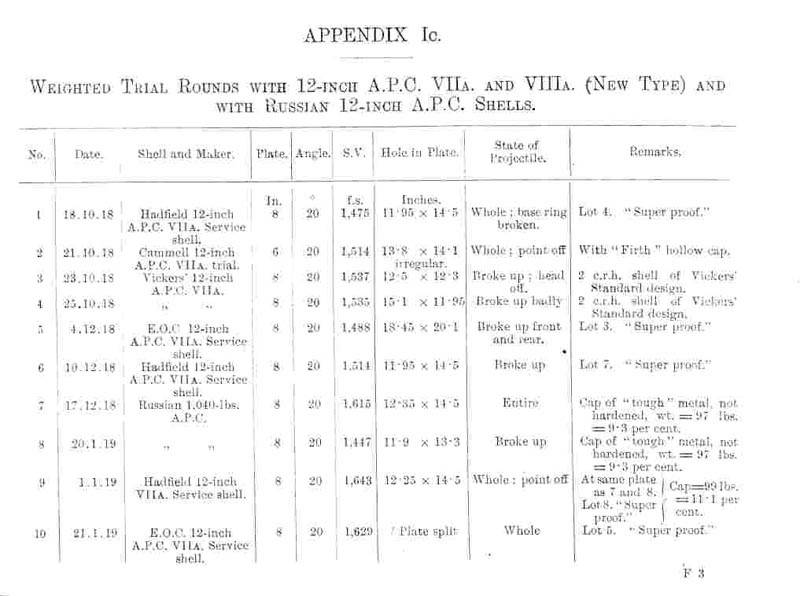
As you can see, 305-mm armor-piercing shells from various British manufacturers were used for shelling, including domestic shells.
The speed of the shells at the time of impact was different, but the angle of deviation from the normal was the same - 20 degrees.
The above data indicate that two Russian shells were used in this shelling. Both of them pierced the British armor.
But the second, which had an impact velocity of 441 m / s (1 feet per second), collapsed (“broke up” in the “State of Projectile” column). From this we can conclude that the second round penetrated the British armor plate at the limit of its capabilities.
If this assumption is correct, then it turns out that the "K" of British armor is approximately 2 or higher. At the same time, due to the fact that individual shots against Russian armor during tests showed a "K" coefficient equal to 374-1750, it can be assumed that British armor was at least 1900% stronger than Russian armor in terms of strength.
However, in my previous materials, I showed that we have no reason to consider the quality of Russian armor below "K" = 2. And that the cases when the value of "K" fell less than the specified one is quite explainable by the damage that the Russian armor plate received during the previous shelling ...
So, for example, the most typical case occurred during shelling of 270 mm armor plate No. 1.
The semi-armor-piercing 356-mm projectile collapsed on impact. And the second, exactly the same and released after the first, hit the armor at the same speed and at the same angle, pierced both the 270 mm armor plate and the 75 mm bulkhead behind it, also made of cemented armor. In the first case, when the armor was not pierced, the ratio of the quality of the armor and the projectile gave the coefficient "K" equal to or higher than 2600. While the second shot gave the coefficient "K" below 1890.
Such a dramatic difference in the results can be explained by the fact that the second shell hit not far from the first. And in the place of his hit, the armor was significantly weakened by the impact of the previous projectile.
But back to the British armor.
Very much doubt is raised by the assumption that the Russian projectile, which collapsed while overcoming the armor, pierced the 203 mm British armor plate at the limit of its capabilities.
The point is this.
Let's take a look at the very first shot in the table above.
The British 305-mm projectile produced by Hadfield, having a significantly lower mass (850 pounds versus 1) and a similar muzzle velocity (040 ft / s versus 1 ft / s), quite successfully penetrates the British 475 mm armor, which testifies to “ K "less than or equal to 1 447. And remains whole. True, another projectile of the same manufacturer, hitting an armor plate of the same thickness at a speed of either 203 or 2 ft / sec (on the scan, alas, it is not clear), collapsed while overcoming it - but, again, pierced the armor.
How can this be?
Maybe it's all about the quality of the British shells, which turned out to be significantly better than the Russians?
This is unlikely - it is enough to look at the photographs of a Russian armor-piercing projectile that pierced 203 mm armor plate at a speed of 1615 ft / s.
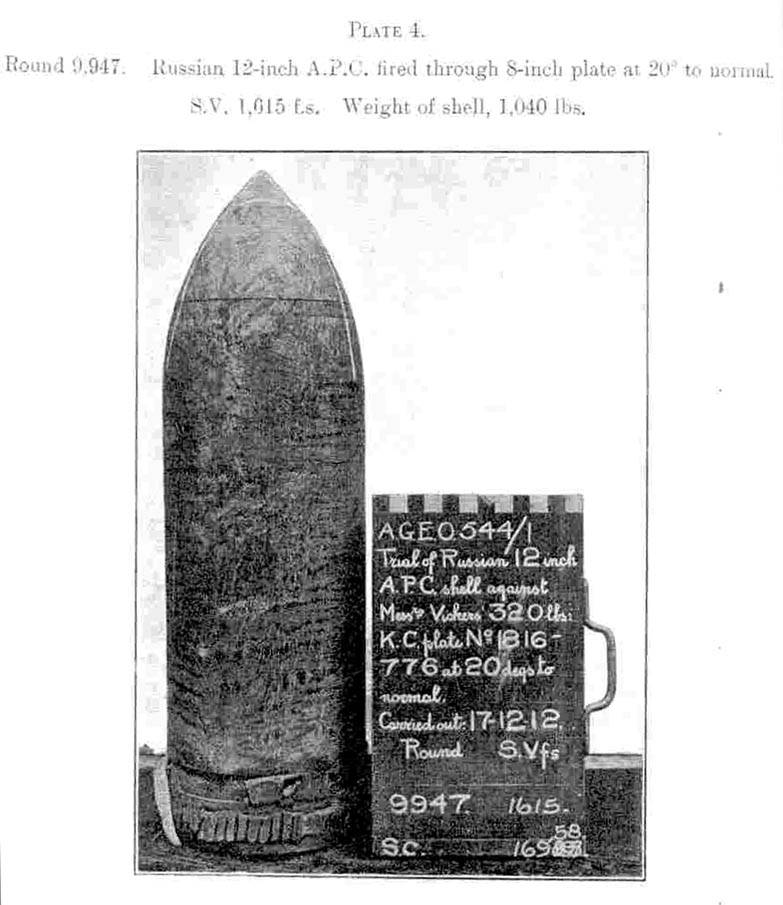
And a British shell produced by the same Hadfield, which also pierced British armor at a speed of 1634 ft / s.
As you can see, both projectiles passed through the armor, retaining the ability to detonate, but the British projectile looks much worse than the Russian one.
In general, it turns out like this - of course, British armor showed noticeably better quality in tests than German or Russian.
But to say that her "K" was 2 is hardly possible. Still, only two shots with Russian shells is too insignificant a sample to make far-reaching conclusions on its basis.
Note that the Russian armor-piercing shells used in the tests almost never shattered, even passing the armor barrier at the limit of their capabilities. So it is possible that we are talking about a defective shell. This version looks closer to the truth, since the shelling by British shells, not superior in quality to the Russians, gave a smaller "K" - no more than 2.
But the most interesting thing is that real combat operations showed even less durability of British armor.
At the Battle of Jutland
Unfortunately, it is very difficult to understand what kind of armor was installed on the dreadnoughts and battle cruisers of the British fleet. But still there is something on this score “on the Internet”.
So, according to Nathan Okun, the British fleet from 1905 to 1925 used the British Krupp Cemented (KC), which was an improved version of the 420 quality Krupp armor. And since the tests described above were carried out in 1918-1919, it should be assumed that this armor was installed on all ships of the Royal Navy.
In contrast to this, one can argue that Okun, alas, is far from always right in his research. And, besides, if a certain armor had the same name for a certain period, this does not mean at all that its qualities remained unchanged.
In the comments to my articles, opinions were repeatedly expressed that the British armors improved their products in 1911 or 1912, or even in 1914. Whether this is so or not - I, alas, do not know.
But why guess?
Consider hitting the battlecruiser Tiger, which, when laid down in 1912, probably had the best cemented armor that British industry could provide.
It is quite obvious that the bulk of British ships (all battleships and all battle cruisers with 305-mm and 343-mm guns) had armor of the same quality or worse.
Of particular interest are two hits in the 229 mm armor of this ship. According to Campbell, at 15:54 a 280mm German shell hit the barbet of Tower X just above the upper deck.
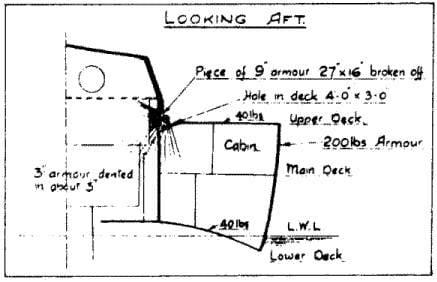
In this case, the British armor was pierced. The shell went inside the barbet and exploded. But he gave an incomplete break, which is why a big catastrophe for the cruiser did not happen.
Almost simultaneously with this, at approximately 15:53, another shell of the same caliber hit the side skin opposite the barbet of tower "A", and then, in fact, hit the barbet. But in this case, the 229 mm British armor was not pierced.
Thus, it can be assumed that in these cases the British armor was at the limit of its durability. At almost the same time, the 229 mm barbets of the cruiser Tiger experienced the impact of 280 mm shells, most likely from the same ship, since the Moltke was firing at the Tiger at that time.
In the case when the German shell hit directly into the barbet, it pierced the armor. And when, before that, he was also opposed by the thin sheathing of the side, he could no longer. Although, of course, the probabilistic nature of the armor penetration could have affected here.
In addition, it is possible that in this case the German shells hit the armor from different angles. Nevertheless, the armor of the barbet is bent, which is why even when firing from the same ship, different angles of deviation from the normal are possible, depending on the places where the shells hit.
Unfortunately, the exact angle of impact of shells on the armor is unknown. But the distance from which the shot was fired is known - 13 yards (or 500 m). At this distance, the 12 mm / 345 shell of the gun had a speed of 279 m / s, and its angle of incidence was 50 degrees.
So, if we assume that this projectile hit the barbet of tower "X" at an ideal angle for itself (the angle of deviation from the normal is equal to the angle of incidence), then even then the resistance of British armor corresponds only to "K" = 2 069. If the angle was different from ideal, then the durability of British armor is even lower!
However, this case also cannot be considered a representative statistical sample.
Perhaps, the probabilistic nature of the armor penetration formula I used here "played". Or maybe the need to create curved armor for barbets has led to some drop in its durability, relative to that achieved in the production of conventional armor plates. It is also likely that the incomplete rupture of the German shell in the barbet of the "X" turret of the cruiser "Tiger" is related to the damage it received while penetrating the armor. In other words, he passed for her, although in general, but not quite workable condition.
However, on the basis of the above, the "K" coefficient of British armor should be determined somewhere in the range of 2100-2200. That is, on the strength of 5-10% stronger than the German and Russian.
Interestingly, this conclusion is indirectly confirmed by some other sources.
About post-war British armor
As you know, in the period between the First and Second World Wars, a famous revolution took place in the manufacture of cemented armor. And the heavy ships of the Second World War received significantly more durable protection.
In the previous article, I have already mentioned the work of T. Evers, in which he talks about a significant change in the chemical composition of the new German armor and recommends using the coefficient "K" in the amount of 2. "At the level" K "= 337 2, the increase in strength is 005%, which is very, very good.
As for the British battleships of the Second World War era, it is more and more interesting with them.
The British themselves believed that their armor retained superiority over the German. And, most likely, the way it really was.
In the book "British, Soviet, French, and Dutch battleships of World War II" (by William H. Garzke and Robert Dulin), dedicated to both actually built and remaining on paper projects of battleships of the Second World War, page 267 indicates the estimated armor penetration 406-mm guns of the battleships "Nelson" and the promising battleships "Lion".
Using the presented data for 1080 kg of the "Lion" projectile, we obtain the shape factor of the projectile 0,3855, the angle of fall at a distance of 13 m - 752 degrees, the speed on the armor - 9,46 m / sec.
The table shows the armor penetration of 449 mm, which, taking into account the indirect relationship between the thickness of the armor and its durability (starting after 300 mm), is 400,73 mm of the "reduced" thickness. Accordingly, the "K" of the British armor plate in this case will be 2.
So, if we assume that the data of these authors (William H. Garzke and Robert Dulin) are correct, it turns out that the British armor of the Second World War was about 9,7% stronger than the German armor of the same period.
And, if we assume that the British improved the quality of their armor in comparison with what they had in 1911, by the same 16,6% as the Germans, it turns out that the coefficient "K" of armor mod. 1911 is 2!
In view of the above, the following conclusion suggests itself.
German and Russian armor of the First World War was roughly equivalent. And their "K" was 2.
British armor was 5-10% stronger (10% - provided that the quality of the British KS remained unchanged since 1905 and that the punched barbet of the "Tiger" is not typical for the characteristics of the durability of British armor).
The improvement of the armor case led to the fact that the German ships, built in the 30s of the twentieth century, received armor with "K" = 2, and the British - with "K" = 337 2.
In other words, the approximately ten percent superiority of the English armor remained.
To be continued ...
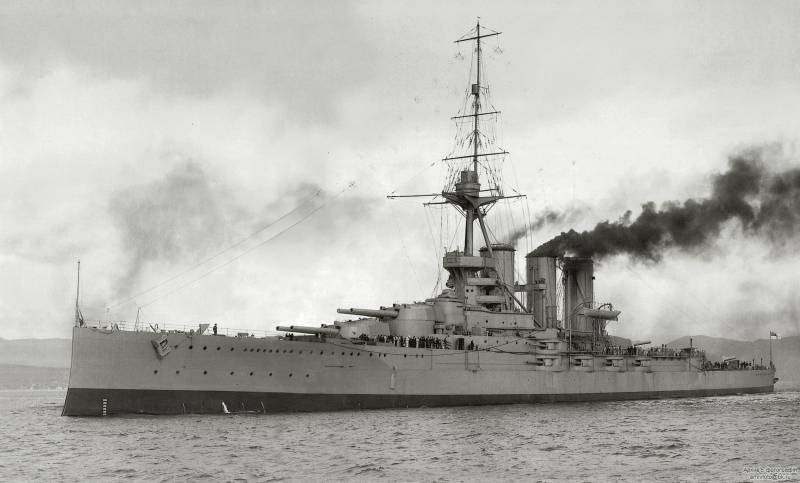
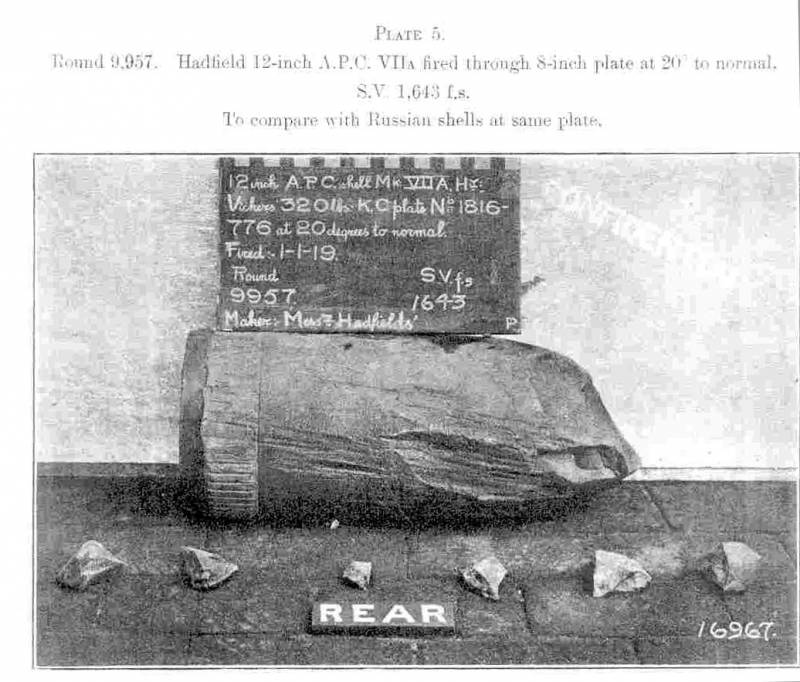
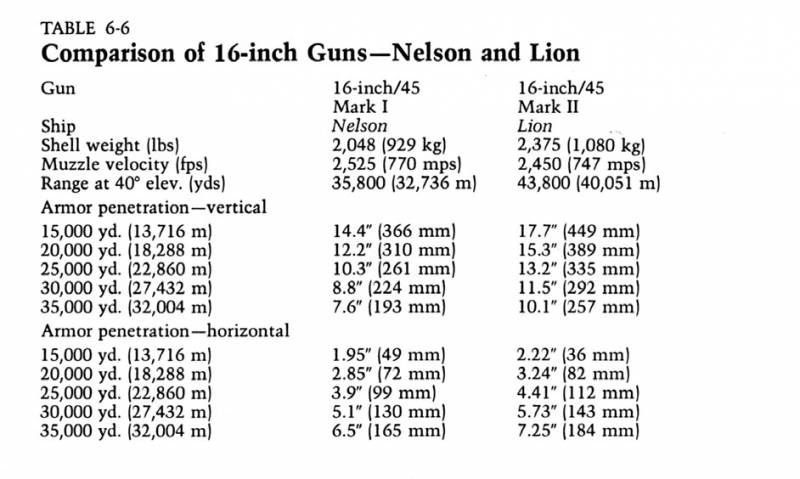
Information